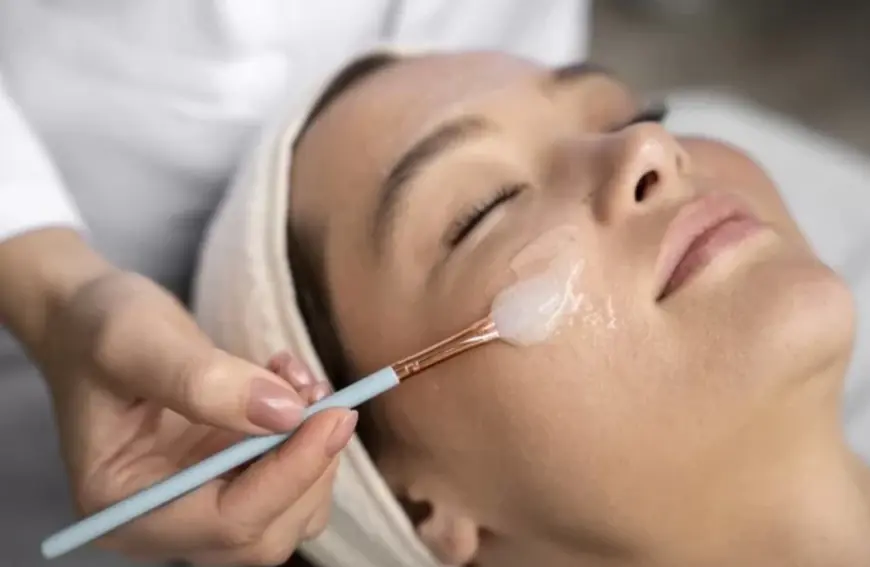Goodbye, Sun Spots! Hello, Clear Skin with Chemical Peels
Say goodbye to sun spots and uneven skin tone with chemical peels. Discover how this professional treatment exfoliates damaged skin, fades pigmentation, and reveals a smoother, clearer, more radiant complexion—safely and effectively

Do you find yourself avoiding the mirror because of uneven skin tone or stubborn sun spots? You’re not alone. Years of sun exposure, even with the best intentions, can lead to discoloration, hyperpigmentation, and a tired-looking complexion. The good news? You don’t have to live with it. Enter one of skincare’s most effective solutions: chemical peels.
Chemical peels have long been a go-to treatment for dermatologists and aestheticians alike—and for good reason. They’re safe, customizable, and proven to deliver dramatic improvements in skin clarity, texture, and brightness. Whether you’re battling years of sun damage or just want a more even glow, chemical peels can help you say goodbye to sun spots and hello to clearer, healthier skin.
What Are Chemical Peels?
A chemical peel is a professional treatment that applies a safe, exfoliating solution to the skin’s surface to remove damaged outer layers. These layers are often where discoloration, rough texture, and fine lines reside. By sloughing them off, chemical peels stimulate skin cell turnover and reveal fresher, smoother, and more radiant skin underneath.
There are various types of peels—from superficial to deep—designed to target different skin concerns. Some work on the surface for mild exfoliation, while others penetrate deeper to correct pigmentation and stimulate collagen production.
Why Do Sun Spots Appear?
Sun spots (also known as solar lentigines or age spots) are flat, brown or dark patches that typically develop on areas frequently exposed to the sun—like the face, hands, chest, and shoulders. They form when UV rays trigger the skin to produce excess melanin, the pigment that gives skin its color.
While sun spots are benign, they can be cosmetically frustrating. Over time, they can multiply and darken, giving the skin an uneven, blotchy appearance. Chemical peels are one of the most effective non-invasive methods to visibly reduce their appearance.
How Chemical Peels Fade Sun Spots
Here’s how chemical peels help turn back the clock on sun-damaged skin:
1. Target Pigment at the Source
Chemical peels contain exfoliating agents such as glycolic acid, trichloroacetic acid (TCA), salicylic acid, or lactic acid. These acids break down melanin clusters and help disperse them, lightening areas of hyperpigmentation over time.
2. Boost Skin Cell Renewal
As the outer layer of dead skin is removed, new skin cells rise to the surface—fresher, more even in tone, and free from the discoloration of sun spots.
3. Improve Skin Tone and Texture
Peels also address other symptoms of sun damage like roughness, fine lines, and dullness, leaving your skin looking and feeling smoother and younger.
For a deeper dive into how this treatment works, check out this guide on the top benefits of chemical peels for treating sun damage and pigmentation.
What to Expect from a Chemical Peel Treatment
Before the Treatment:
- Your skincare provider will assess your skin type and recommend the appropriate peel strength.
- You may be asked to prep your skin with a gentle cleanser or brightening products for a few days prior.
During the Treatment:
- The peel solution is applied to your skin and left on for a few minutes.
- You may feel a mild tingling or warming sensation.
- The skin may appear pink or slightly red afterward.
After the Treatment:
- Over the next few days, the skin may flake or peel depending on the depth of the treatment.
- Sunscreen is critical—your new skin will be more sensitive to UV rays.
- Within a week, expect a noticeable improvement in brightness, clarity, and tone.
How Many Sessions Are Needed?
Many clients see improvements after just one treatment, but for significant sun damage or stubborn pigmentation, a series of 3–6 treatments spaced 3–4 weeks apart may be recommended. Regular maintenance peels every few months can help keep your complexion even and glowing.
Who Should Consider Chemical Peels?
Chemical peels are suitable for most skin types and tones. You may be an ideal candidate if you:
- Have visible sun spots, freckles, or pigmentation
- Experience uneven tone or rough skin texture
- Struggle with dullness or lack of radiance
- Are looking for non-invasive skin rejuvenation
- Want smoother, softer, and clearer skin
Always consult a licensed skincare professional to determine the best peel type for your skin needs.
Combine Peels with Other Skin Treatments
For maximum results, chemical peels can be paired with other professional skincare treatments. A perfect complement is SkinPen microneedling, which stimulates collagen production and helps improve skin firmness and elasticity. Together, these treatments can address both the surface signs of sun damage and the underlying structural issues like fine lines and laxity.
What's Your Reaction?
 Like
0
Like
0
 Dislike
0
Dislike
0
 Love
0
Love
0
 Funny
0
Funny
0
 Angry
0
Angry
0
 Sad
0
Sad
0
 Wow
0
Wow
0



















































